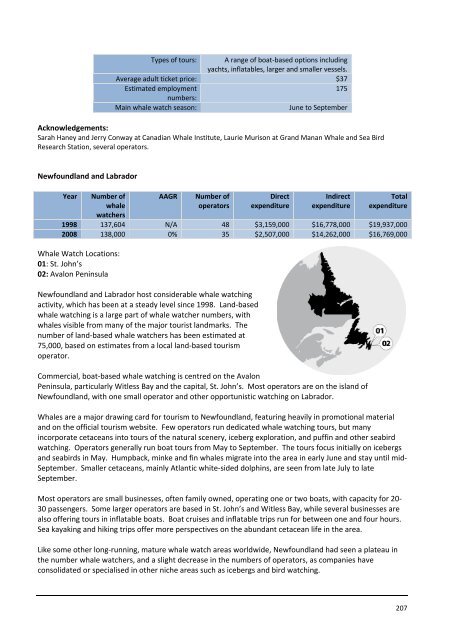Whale Watching Worldwide
Whale Watching Worldwide
Whale Watching Worldwide
Create successful ePaper yourself
Turn your PDF publications into a flip-book with our unique Google optimized e-Paper software.
Types of tours: A range of boat‐based options including<br />
yachts, inflatables, larger and smaller vessels.<br />
Average adult ticket price: $37<br />
Estimated employment<br />
numbers:<br />
175<br />
Main whale watch season: June to September<br />
Acknowledgements:<br />
Sarah Haney and Jerry Conway at Canadian <strong>Whale</strong> Institute, Laurie Murison at Grand Manan <strong>Whale</strong> and Sea Bird<br />
Research Station, several operators.<br />
Newfoundland and Labrador<br />
Year Number of<br />
whale<br />
watchers<br />
AAGR Number of<br />
operators<br />
Direct<br />
expenditure<br />
Indirect<br />
expenditure<br />
Total<br />
expenditure<br />
1998 137,604 N/A 48 $3,159,000 $16,778,000 $19,937,000<br />
2008 138,000 0% 35 $2,507,000 $14,262,000 $16,769,000<br />
<strong>Whale</strong> Watch Locations:<br />
01: St. John’s<br />
02: Avalon Peninsula<br />
Newfoundland and Labrador host considerable whale watching<br />
activity, which has been at a steady level since 1998. Land‐based<br />
whale watching is a large part of whale watcher numbers, with<br />
whales visible from many of the major tourist landmarks. The<br />
number of land‐based whale watchers has been estimated at<br />
75,000, based on estimates from a local land‐based tourism<br />
operator.<br />
Commercial, boat‐based whale watching is centred on the Avalon<br />
Peninsula, particularly Witless Bay and the capital, St. John’s. Most operators are on the island of<br />
Newfoundland, with one small operator and other opportunistic watching on Labrador.<br />
<strong>Whale</strong>s are a major drawing card for tourism to Newfoundland, featuring heavily in promotional material<br />
and on the official tourism website. Few operators run dedicated whale watching tours, but many<br />
incorporate cetaceans into tours of the natural scenery, iceberg exploration, and puffin and other seabird<br />
watching. Operators generally run boat tours from May to September. The tours focus initially on icebergs<br />
and seabirds in May. Humpback, minke and fin whales migrate into the area in early June and stay until mid‐<br />
September. Smaller cetaceans, mainly Atlantic white‐sided dolphins, are seen from late July to late<br />
September.<br />
Most operators are small businesses, often family owned, operating one or two boats, with capacity for 20‐<br />
30 passengers. Some larger operators are based in St. John’s and Witless Bay, while several businesses are<br />
also offering tours in inflatable boats. Boat cruises and inflatable trips run for between one and four hours.<br />
Sea kayaking and hiking trips offer more perspectives on the abundant cetacean life in the area.<br />
Like some other long‐running, mature whale watch areas worldwide, Newfoundland had seen a plateau in<br />
the number whale watchers, and a slight decrease in the numbers of operators, as companies have<br />
consolidated or specialised in other niche areas such as icebergs and bird watching.<br />
207

















